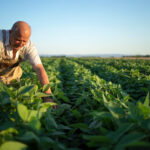Spice farming is gaining momentum in South Africa, driven by growing local demand, a thriving culinary scene, and export opportunities. While South Africa may not be traditionally known for spice production, its diverse climate zones offer excellent conditions for cultivating a range of high-value spices. For small-scale and commercial farmers alike, identifying the most profitable spices to grow can open up new income streams and agribusiness potential.
Turmeric is one of the most in-demand spices globally, valued for its medicinal, culinary, and cosmetic uses. In South Africa, turmeric thrives in warm, frost-free areas with moderate rainfall and well-drained, loamy soil. Provinces like KwaZulu-Natal and parts of Limpopo offer suitable growing conditions. Turmeric requires 7–9 months to mature and yields a vibrant yellow rhizome that can be sold fresh or dried and ground. With the rising popularity of natural health products and golden milk lattes, the market for turmeric continues to expand.
Ginger is another high-profit spice crop that grows well in South Africa’s subtropical regions. Like turmeric, ginger grows from rhizomes and prefers humid, well-watered environments with partial shade. The South African market has seen a steady increase in demand for ginger due to its health benefits, especially as an immune booster. Farmers can sell ginger fresh, dried, or processed into oils and extracts. KwaZulu-Natal, Mpumalanga, and parts of the Eastern Cape are ideal areas for ginger cultivation.
Chilli peppers—particularly the hotter varieties like bird’s eye, habanero, and jalapeño—are both easy to grow and highly profitable. Chilli farming requires minimal space and grows well in warm, sunny climates. South Africa’s culinary culture increasingly embraces spicy food, and the demand for fresh and dried chillies is high across supermarkets, restaurants, and food processing companies. Small-scale chilli farmers also have the option of producing chilli powders, sauces, and pickles to increase value and profit margins.
Coriander (also known as dhania) is a dual-purpose plant grown for both its leaves and seeds. Coriander grows best in cooler seasons and requires minimal input, making it an ideal crop for small farmers looking to diversify. The seeds can be harvested, dried, and packaged for use in spice blends, while the fresh leaves are popular in South African and Indian-inspired cuisine. Coriander grows quickly, allowing multiple harvests in a single year with good market returns.
Garlic may not be a traditional spice, but it’s a high-value crop in the spice and seasoning category. South African consumers use garlic in almost every home-cooked meal, making it a staple with consistent demand. Garlic requires well-drained soil, cool temperatures during early growth, and a long growing season. Hardneck and softneck varieties can be grown depending on the region. Although it takes 6–9 months to mature, garlic yields a good return and stores well for year-round sales.
Saffron, known as the world’s most expensive spice, can be cultivated in parts of South Africa with cold winters and hot, dry summers—conditions needed for its corms (bulbs) to thrive. While it requires careful handling and labor-intensive harvesting, even a small area can yield a significant profit due to saffron’s high market value. Farmers in the Western Cape and parts of Free State are beginning to explore saffron cultivation as a niche opportunity.
Basil, while more commonly used as a herb, is another profitable crop with potential in the spice industry. Sweet basil grows quickly and is in high demand for pesto, seasoning blends, and essential oil extraction. Basil requires a warm growing season, regular irrigation, and pest control but can be harvested multiple times per season, offering excellent returns for small landholders.
Growing spices in South Africa offers a promising path to profitability for farmers willing to invest in the right crops and cultivation techniques. From ginger and turmeric to chillies and garlic, each spice offers unique market opportunities, especially when sold directly to consumers, health food stores, or processed into value-added products. With increasing interest in healthy, flavorful food and natural remedies, spice farming is set to become a lucrative niche in the South African agricultural sector.







